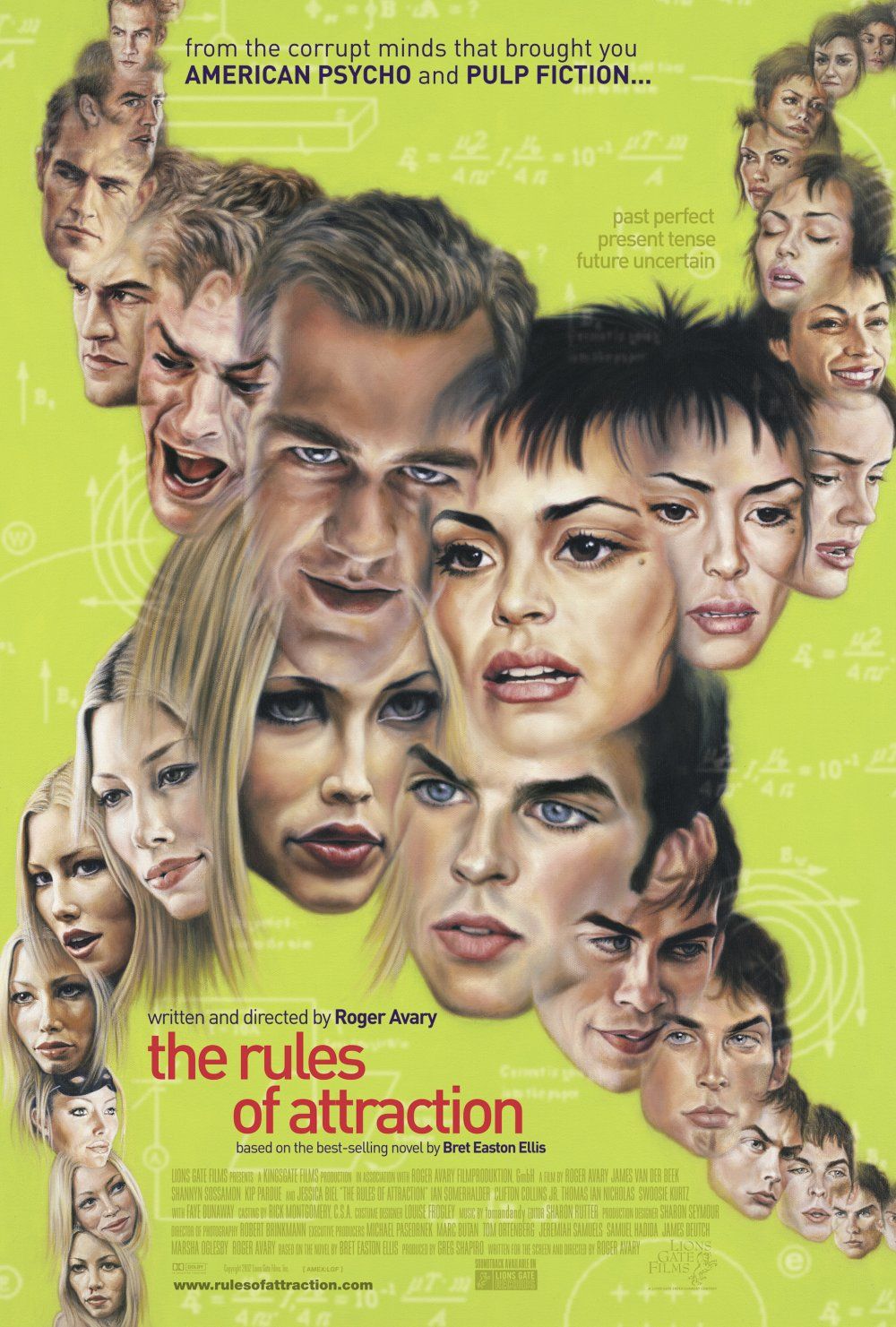
- Starring
- James Van Der Beek, Shannyn Sossamon, Jessica Biel
- Writer
- Roger Avary
- Director
- Roger Avary
- Rating
- 18A (Canada), R (United States)
- Running Time
- 110 minutes
Overall Score
Rating Summary
The Rules of Attraction is a defiantly pointless film. It stays true to the spirit of a lot of Bret Easton Ellis’s work by proudly flaunting the fact that it is postmodern and willing to use shock tactics to keep the audience engaged, without really having anything to say. He gets so self-indulgent with his own ways that it feels like he tries too hard by going out of his way to convince viewers that he’s really, really cool. Ellis is willing to emotionally distance himself from violent rape, and has the rape victim complain about the social status of her rapist, rather than taking issue with the sexual assault that she is being submitted to. Avary seemingly decided that he didn’t need to put his own spin on Easton Ellis’s novel, so the result is a film that does feel true to the author’s vision. Personally, it might have worked better if Avary had pushed back against some of performative coolness of Ellis’s writing.
The Rules of Attraction is ostensibly about a love triangle, but it’s hard to get a sense that anybody is truly searching for love. It is set at Camden College, a university that is infamous for the amount of partying that the students engage in. The love triangle draws together wealthy drug dealer Sean Bateman (Van Der Beek), randy virgin Lauren Hyde (Sossamon) and bisexual student Paul Denton (Ian Somerhalder). Bateman is infatuated with the sweet, innocent Lauren, and erroneously believes that the purple love letters that he has been receiving are from her. Hynde is mostly concerned with losing her virginity to a person who occupies the same social strata as her. She still pines for her ex-boyfriend Victor (Kip Pardue), who has completely changed since returning from a holiday in Europe. She used to date Denton, but his attention has shifted to Bateman and he desperately wants to have sex with him. Bateman isn’t attracted to Denton, and as he tries to capture Hynde’s heart, he ends up hurting Denton’s feelings.
Ellis clearly didn’t intend to tell a tightly plotted story. He seems more interested in providing a snapshot of people’s lives at a particular point in time, and commenting on the bizarre personality quirks that people can adopt while in university. He wants to capture the college atmosphere, but also aims to provide a heightened evocation of what that experience might have been like. People party hard every weekend and everyone is strangely emotionless when horrible things happen to them. This creates a bizarre effect and turns this into a style over substance affair.
With The Rules of Attraction, Avary mostly succeeds when he is allowed to produce scenes that feel like they could be a music video. Like his former collaborator, Quentin Tarantino, he enjoys repurposing old pop songs and inserting them into dialogue-free scenes in which they provide an ironic accompaniment to the visuals that they have created. It’s a technique that helped Tarantino to gain notoriety and by using this intertextuality, both Tarantino and Avary manage to sell the audience on the idea that they are also cultured music nerds with wide ranging knowledge of hit singles from 1976. Avary deploys this trick when staging a scene that involves the suicide of a love struck young girl who is hurt after seeing her crush with another girl. She eases into a bath and proceeds to kill herself with a disturbing amount of technical precision. All of this is set to Harry Nilsson’s “Without You”, a classic power ballad about a man who feels like he can’t live without the woman that he loves. The lyrics echo the sentiments that the girl expressed in her suicide note, but there is something upsetting about the fact that the song is a swooning romantic ballad, and it seems inappropriate to pair it with images of a girl dying. It’s all in poor taste, but Avary is aiming to produce something that is tasteless and incendiary. At least he hits all of his targets in this scene.
Avary also succeeds in creating a film that really does have a unique, immediately recognizable aesthetic. While that aesthetic should had been applied to a story about characters who were actually engaging, his commitment to world building was admirable. He never falters in creating a shiny, plastic-y world in which nothing serious really happens. Maybe he intended for this to be a biting satire or a blistering comedy, but it isn’t funny or observant enough to slide into those categories.
In the end, those looking for something mildly entertaining and occasionally bizarre, The Rules of Attraction might do trick. For those looking for something that can get them to do more than occasionally gasp, they will be terribly disappointed. Those looking for some provocative entertainment should watch a Lina Wertmüller film as they ask viewers to seriously think about the content being presented on screen.
still courtesy of Lionsgate
Follow me on Twitter.
If you liked this, please read our other reviews here and don’t forget to follow us on Twitter or Instagram or like us on Facebook.

I am passionate about screwball comedies from the 1930s and certain actresses from the Golden Age of Hollywood. I’ll aim to review new Netflix releases and write features, so expect a lot of romantic comedies and cult favourites.
Discover more from
Subscribe to get the latest posts sent to your email.
